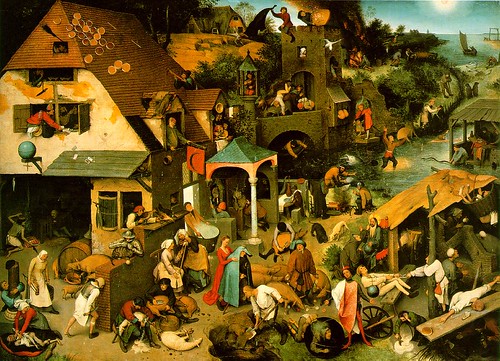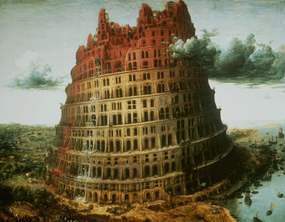 "These paintings are full of naturalistic detail.
"These paintings are full of naturalistic detail. The miniature are remarkable for their
mastery in rendering space strongly suggesting
that one or more of the brothers had visited
Italy, and they occupy an important place in
the development of the northern traditions of
landscape and genre painting."
By the end of the 14th century, the fusion of Italian and Northern European art had led to the development of an International Gothic style. For the next quarter of a century, leading artists travelled from Italy to France, and vice versa, and all over Europe. As a consequence, ideas spread and merged, until eventually painters in this International Gothic style could be found in France, Italy, England, Germany, Austria and Bohemia. The International Gothic Style can be described by pointing out its absolute taste for beautiful flowing lines and for dainty motives, the immense desire of refined and elegance, the particular care given to small precise work and the extreme attention to the decorative details. Among the many characteristics that defines this style we can see an intense attention to the realistic and naturalistic contents that shows the artists’ acute observation of human beings and nature. However, because the lack of space the manuscripts and all the small works were over loaded with thin elaborated figures wearing highly fashionable clothes. Foreshortening could be seen on the individual and on the exotic animals. The use of precious materials, again gold, very rare minerals, plants or chemicals, in creating colours; the use of perspective and proportions, even though, in specific ways appealing to the artists’ taste. Human figures, landscapes and spaces in a realistic approach were accompanied by a peculiar quality of dreams, decorative dimension and deep emotional charges. Another very important method that defined this style was that the artist started actually to study the nature and used a sketchbook, and started to gather up groups of sketches of rare and beautiful plants and animals. Where before was sufficient to have just a general knowledge of all and then to adopted into different work of art.
 The Limburg brothers book of hours, Les Trè Riches Heures du Duc de Berry, is considered by common consent one of the supreme masterpieces of manuscript illumination and the archetype of the International Gothic Style. The twelve-page illustration of the months is superb, for the first time a calendar was so lavishly treated. Full of exquisite ornamentation and the naturalistic details are amazingly observed, which strongly suggest their studies on this matter. To conceive this book the Limburg brothers have used a wide variety of colours obtained from minerals, plants or chemicals and mixed with either Arabic or tragacinth gum to provide a binder for the paint. Some of the minerals and materials used to produce these colours were extremely expensive, precious and rare like the Middle Eastern lapislazuli to paint brilliant blues or the green made with especial plants. Moreover all their work, which were executed with amazing fine details and surprising beauty, needed to be achieved with precise and specific brushes and almost certainly lenses.
The Limburg brothers book of hours, Les Trè Riches Heures du Duc de Berry, is considered by common consent one of the supreme masterpieces of manuscript illumination and the archetype of the International Gothic Style. The twelve-page illustration of the months is superb, for the first time a calendar was so lavishly treated. Full of exquisite ornamentation and the naturalistic details are amazingly observed, which strongly suggest their studies on this matter. To conceive this book the Limburg brothers have used a wide variety of colours obtained from minerals, plants or chemicals and mixed with either Arabic or tragacinth gum to provide a binder for the paint. Some of the minerals and materials used to produce these colours were extremely expensive, precious and rare like the Middle Eastern lapislazuli to paint brilliant blues or the green made with especial plants. Moreover all their work, which were executed with amazing fine details and surprising beauty, needed to be achieved with precise and specific brushes and almost certainly lenses.Labels: art, International Gothic, Les Trè Riches Heures du Duc de Berry, Painting
 This place, O youths, I protect, nor less this turfbuilded cottage, Roofed with its osier-twigs and thatched with its bundles of sedges; I from the dried oak hewn and fashioned with rustical hatchet, Guarding them year by year while more are they evermore thriving. [5] For here be owners twain who greet and worship my Godship, He of the poor hut lord and his son, the pair of them peasants: This with assiduous toil aye works the thicketty herbage And the coarse water-grass to clear afar from my chapel: That with his open hand ever brings me offerings humble. Hung up in honour mine are flowery firstlings of spring-tide, [20] Wreaths with their ears still soft the tender stalklets a-crowning; Violets pale are mine by side of the poppy-head pallid; With the dull yellow gourd and apples sweetest of savour; Lastly the blushing grape disposed in shade of the vine-tree. Anon mine altar (this same) with blood (but you will be silent!) [15] Bearded kid and anon some horny-hoofed nanny shall sprinkle. Wherefore Priapus is bound to requite such honours by service, Doing his duty to guard both vineyard and garth of his lordling. Here then, O lads, refrain from ill-mannered picking and stealing: Rich be the neighbour-hind and negligent eke his Priapus: [20] Take what be his: this path hence leadeth straight to his ownings.
This place, O youths, I protect, nor less this turfbuilded cottage, Roofed with its osier-twigs and thatched with its bundles of sedges; I from the dried oak hewn and fashioned with rustical hatchet, Guarding them year by year while more are they evermore thriving. [5] For here be owners twain who greet and worship my Godship, He of the poor hut lord and his son, the pair of them peasants: This with assiduous toil aye works the thicketty herbage And the coarse water-grass to clear afar from my chapel: That with his open hand ever brings me offerings humble. Hung up in honour mine are flowery firstlings of spring-tide, [20] Wreaths with their ears still soft the tender stalklets a-crowning; Violets pale are mine by side of the poppy-head pallid; With the dull yellow gourd and apples sweetest of savour; Lastly the blushing grape disposed in shade of the vine-tree. Anon mine altar (this same) with blood (but you will be silent!) [15] Bearded kid and anon some horny-hoofed nanny shall sprinkle. Wherefore Priapus is bound to requite such honours by service, Doing his duty to guard both vineyard and garth of his lordling. Here then, O lads, refrain from ill-mannered picking and stealing: Rich be the neighbour-hind and negligent eke his Priapus: [20] Take what be his: this path hence leadeth straight to his ownings.
 Dalla terrazza del Café Glacier o dai tavolini del Café Paris si potrà godere appieno del brulicante formicolio di questa piazza. Sorseggiando un tè alla menta e aspettando il tramonto quando il cielo si arrossa e le lampade ad acetilene dei venditori rischiarano la piazza. La Medina con il souk è una delle più belle del Marocco (con quella di Fes). È consigliabile affidarsi ad una guida per evitare di perdersi tra vicoli e androni. Si inizia con il souk Semmarine dove troneggiano stoffe e broccati, per poi passare al souk Attarine, regno degli artigiani del rame. Poco distante il souk Smata, dedicato esclusivamente alle babbucce, e poi il souk El Kebir con negozi di pelletteria. Per chi non fosse ancora stanco c'è il souk Haddine, quello dei fabbri, e la piazza Rahha Kedima che ospita il mercato degli ortaggi e del pollame. Dopo tutta questa camminata ci si può ristorare al Café de Paris o optare per una più romantica gita in carrozzella lungo le mura. Il rosso del tramonto le infiamma e le cicogne tornano ai propri nidi. Per gli amanti dei giardini, la visita d'obbligo è alla Majorelle, tra ninfee e bambù...
Dalla terrazza del Café Glacier o dai tavolini del Café Paris si potrà godere appieno del brulicante formicolio di questa piazza. Sorseggiando un tè alla menta e aspettando il tramonto quando il cielo si arrossa e le lampade ad acetilene dei venditori rischiarano la piazza. La Medina con il souk è una delle più belle del Marocco (con quella di Fes). È consigliabile affidarsi ad una guida per evitare di perdersi tra vicoli e androni. Si inizia con il souk Semmarine dove troneggiano stoffe e broccati, per poi passare al souk Attarine, regno degli artigiani del rame. Poco distante il souk Smata, dedicato esclusivamente alle babbucce, e poi il souk El Kebir con negozi di pelletteria. Per chi non fosse ancora stanco c'è il souk Haddine, quello dei fabbri, e la piazza Rahha Kedima che ospita il mercato degli ortaggi e del pollame. Dopo tutta questa camminata ci si può ristorare al Café de Paris o optare per una più romantica gita in carrozzella lungo le mura. Il rosso del tramonto le infiamma e le cicogne tornano ai propri nidi. Per gli amanti dei giardini, la visita d'obbligo è alla Majorelle, tra ninfee e bambù...

 The Limburg brothers book of hours,
The Limburg brothers book of hours, 











